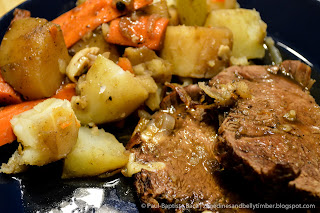~Diane Ackerman, A Natural History of the Senses
We are shut away as the weather turns cold, our doors and windows fast against the chill, closing out the world around us we so enjoy when the weather is more pleasant. Yet it is not without advantage. Closing homes against Jack Frost means also that they fill with the sights, sounds, and smells of domesticity to greet us when we escape from the bitter weather. There is nothing quite as comforting as coming home to warmth and the smells of cooking.
One of my favorite cold-weather dishes is pot roast. It is simple and straightforward. Hearty. And you cook this one with wine.
The smell of this cooking is certain to raise spirits and increase appetites.
Red Wine Pot Roast
3 pounds boneless beef chuck roast
2 Tbs olive oil
½ cup water
½ cup red wine
1 tsp whole pepper corns
2 tsp salt
1 bulb of garlic, each clove peeled and sliced lengthwise
1 onion, sliced
6 medium potatoes, washed and cut into 2-inch pieces
3 large carrots, peeled, halved, and cut into 2-inch lengths
6 celery stalks, cut into 2-inch lengths
Preheat an oven to 350º F.
Heat the olive oil over medium-high heat in an oven-proof Dutch oven with a tight-fitting lid. Brown the roast on all sides and remove from the heat.
With a sharp, thin knife - I use a fillet knife - make small cuts on the surface of the roast and insert the garlic cloves.
Pour in the water and wine. Sprinkle the roast with the salt and pepper corns. Arrange the onion slices on and around the roast.
Cover the Dutch oven and bake in the preheated oven for 2 hours.
While the roast is cooking prepare the potatoes, carrots, and celery.
After 2 hours, add the potatoes, carrots, and celery. Check the moisture of the roast and add some additional water if it looks dry. Continue baking covered for another hour.
The roast is best served au jus, which just means you use the remaining liquid from the Dutch oven as a kind of light gravy over the meat. If the liquid is sparse after removing the meat, just add a little more red wine and heat it in the Dutch oven over a medium heat.
Enjoy!



















